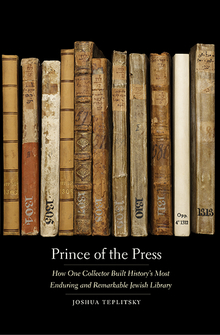Oppenheim’s Library: A Window into Jewish Culture
Joshua Teplitsky—
In January of 2019, Netflix launched a new television program for audiences who had enjoyed previous “home improvement” style shows about living more efficiently with greater style and less clutter called “Tidying up with Marie Kondo.” The show’s primary goal was to help people get rid of unnecessary clutter of clothes and chotchkes by keeping only items that “spark joy” in their lives. But the program raised hackles when rumors began to circulate that the titular host had suggested that no home should have more than thirty books. An internet tempest-in-a-teapot erupted across social media platforms, especially among bibliophiles of all stripes, for whom books are the very epitome of personal joy as they capture the experience of private reading, shared stories, and, just as often, the memories of how those books came to be owned in the first place.
Now, it turns out that the opinions attributed to Kondo were somewhat exaggerated, but the reaction to them touched a nerve familiar to lovers of books across the ages. In no small part, this is because books are unlike other household objects. Books occupy a strange place between commercial things driven by market forces, expressions of creative or intellectual activity, and objects of affection with deeply personal histories. It is this tension surrounding how to understand the meaning and importance of a book to its users that animates the historical investigation of the library of David Oppenheim of Prague in Prince of the Press. David Oppenheim of Prague (1664–1736) amassed a collection of 4,500 printed books and 1,000 manuscripts that bear witness to Jewish literature, cultures, and practices of the Middle Ages and early modern period in European, Mediterranean, and even Middle Eastern history. But his library was more than a treasury of scholarly resources. In Oppenheim’s hands—on account of his particular position in time and place—books were a medium for encounters between people of varying social categories and classes, were currencies of political favor, and were vehicles for scholarly self-fashioning, competition, and, occasionally, incrimination.
Oppenheim participated in a drive to collect literary materials that had gained currency across the continent in the courts of emperors, kings, and nobles. Born in 1664 into a family of great economic and political involvement in the rebuilding of the German lands in the years after the Thirty Years’ War, his uncles and fathers-in-law served as Court Jews, members of a small class of wealthy, closely interconnected men (and sometimes women) who provided financial services to princes and emperors across Central Europe. Their uniquely privileged standing created a state of affairs in which they often operated as nobles in their own communities. This involved financially supporting other Jews of lower social and economic standing, and, in exchange, acting as their unofficial (and sometimes official) leaders.
And, like the politics of those courts, the culture of which was transmitted through his uncles and fathers-in-law who participated in them, Jewish politics was conducted not only through formal rules and constitutions, but through informal ties of patronage. In Oppenheim’s library we can observe all of these elements converging. His collection housed objects of opulence and beauty alongside cheap pamphlets of Yiddish song and fable. He owned communal statutes, legal treatises, rabbinic sermons, prayerbooks, biblical commentaries, Talmudic discourses, and scientific manuscripts.
The purposes of these books were aesthetic as well as utilitarian. Sometimes they predated Oppenheim’s life by centuries; at other times they were specifically commissioned for this use. Even when the texts were of ancient provenance, they were prefaced with a cover page, an ex libris of sorts, which represented their owner through reference to his namesake, the biblical King David. The message would be clear: Oppenheim identified with the majesty and authority of the Bible’s most prominent Israelite king. His library was an accoutrement—and a source—of power.
The flow of these books reveals much more than the collecting appetites of a single man. They were not simply objects with a terminus; they are items that reflect the myriad ties across borders and between communities that Jews maintained because of their circumstances as a diasporic people. The dedications, printed introductions, and manuscript inscriptions revealed the world of social ties between people of various stations. Sometimes a printed introduction revealed the ways that Oppenheim had mentored a student. At other times they elaborated upon a discovery of a manuscript and the permission that was granted by Oppenheim, as its keeper, to an aspiring publisher to print the text and widely disseminate it. At still other times individual items revealed the expectations of sources who had sent manuscripts to Oppenheim as gifts in the hope that he might positively influence the conditions of the sender, either by intervening in professional contests or by transmitting much-needed charitable donations to the communities of the manuscripts’ origin.
It was this culture of exchange that converged on Oppenheim as a bibliophile, scholar, and member of European Jewry’s wealthiest families that brought him great prestige in Jewish communities across Central Europe, Italy, and even the Ottoman Empire. Visitors marveled at its scope and scale. The most detailed description by a visitor to the collection comes not from Jewish users, but from a Christian lawyer and diplomat Johan Anderson (1674–1743) in December 1713. Writing to spread word of this Jewish marvel to other interested Christians, he reported on its contents as
at least 6000 volumes and surely 2000 manuscripts written all over the Jewish world . . .
Of them many, as he (son-in-law) tells me, and also presumably, have still never been printed. Although I myself cannot read [i.e., the Hebrew language], he showed me an item of the Bible written on large parchment, consisting of the Torah, the Prophets, and the Writings, probably of very ancient age, and a similar one in small format written very neatly for a wealthy Jew a few years ago, with the Masora in the margin and on every side in special fashion borders, lines, and leaves, animals and fish, some of them microscopic . . .
Among the printed volumes one can find an astounding quantity of Bibles, all of the editions of the Talmud, and prayers printed from entirely unknown locations and small villages—among other books.
But the collector was as fascinating as the collection. The visitor made one further observation:
The great correspondence, which Oppenheim’s couriers undertake across the entire world, yields the advantage that he is held as rabbi throughout the imperial domains and Poland, as well as in Venice and Jerusalem.
Correspondents from across the map wrote him letters soliciting his scholarly advice. In 1701 his philanthropic activities—facilitated in part by the trade of manuscripts from Jerusalem—resulted in his being named “Prince of the Land of Israel.” By 1718, this very title was put on trial, as accusers in Prague attempted to tar him with the brush of treason on account of his holding a royal title to a far-away city under a rival empire.
And so the library of David Oppenheim is more than just a static collection of artifacts. Its contents reveal a dynamic set of social relations as this trove of sources opens a window into the social life of the exchange of objects and is a means to encounter the people who were involved in transmitting culture—communal scribes, merchants, charity officers, Christian publishers, Jewish rabbis, and university librarians, women and men, rich and poor. Its owner often referred to himself as a “man whose greatest joy was with books.” Each and every one certainly “sparked joy” for him, and not a single one would be discarded in the process of tidying up.
Joshua Teplitsky is assistant professor of history at Stony Brook University. He specializes in the history of the Jews in Europe in the early modern period and in the study of books and media.
Further Reading:



























